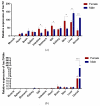The Role of the Heat Shock Cognate Protein 70 Genes in Sex Determination and Differentiation of Chinese Tongue Sole (Cynoglossus semilaevis)
- PMID: 36835170
- PMCID: PMC9964925
- DOI: 10.3390/ijms24043761
The Role of the Heat Shock Cognate Protein 70 Genes in Sex Determination and Differentiation of Chinese Tongue Sole (Cynoglossus semilaevis)
Abstract
Fish sex determination can be affected by environmental temperature. This process relies on temperature-sensitive proteins such as heat shock proteins (HSPs). Our previous work found that heat shock cognate proteins (HSCs) may participate in high-temperature associated sex reversal of Chinese tongue sole (Cynoglossus semilaevis). However, the role of hsc genes in responding to high temperature and affecting sex determination/differentiation remains unclear. Here, by using C. semilaevis as model, we identified hsc70 and hsc70-like. hsc70 was abundant in the gonads with a testicular-higher expression at all gonadal development stages except for 6 months post fertilization (mpf). Intriguingly, hsc70-like showed higher expression in testes from 6 mpf on. Both long-term heat treatment during the temperature-sensitive sex-determining period and short-term heat stress at the end of this period caused different expression of hsc70/hsc70-like between sexes. The dual-luciferase assay results also suggested that these genes can respond to high temperature rapidly in vitro. Heat treatment of C. semilaevis testis cells overexpressed with hsc70/hsc70-like could affect the expression of sex-related genes sox9a and cyp19a1a. Our results indicated that hsc70 and hsc70-like were key regulators linking external high-temperature signals with sex differentiation in vivo and provide a new idea for understanding the mechanism by which high temperature affects sex determination/differentiation in teleosts.
Keywords: Cynoglossus semilaevis; high temperature; hsc70 genes; sex determination and differentiation.
Conflict of interest statement
The authors declare no conflict of interest.
Figures








Similar articles
-
Identification and Functional Analysis of foxo Genes in Chinese Tongue Sole (Cynoglossus semilaevis).Int J Mol Sci. 2023 Apr 21;24(8):7625. doi: 10.3390/ijms24087625. Int J Mol Sci. 2023. PMID: 37108789 Free PMC article.
-
Transcriptome of Gonads From High Temperature Induced Sex Reversal During Sex Determination and Differentiation in Chinese Tongue Sole, Cynoglossus semilaevis.Front Genet. 2019 Nov 22;10:1128. doi: 10.3389/fgene.2019.01128. eCollection 2019. Front Genet. 2019. PMID: 31824559 Free PMC article.
-
Intensive masculinization caused by chronic heat stress in juvenile Cynoglossus semilaevis: Growth performance, gonadal histology and gene responses.Ecotoxicol Environ Saf. 2022 Mar 1;232:113250. doi: 10.1016/j.ecoenv.2022.113250. Epub 2022 Feb 1. Ecotoxicol Environ Saf. 2022. PMID: 35121259
-
Identification of global alternative splicing and sex-specific splicing via comparative transcriptome analysis of gonads of Chinese tongue sole ( Cynoglossus semilaevis).Zool Res. 2022 May 18;43(3):319-330. doi: 10.24272/j.issn.2095-8137.2021.406. Zool Res. 2022. PMID: 35301828 Free PMC article.
-
Early response to heat stress in Chinese tongue sole (Cynoglossus semilaevis): performance of different sexes, candidate genes and networks.BMC Genomics. 2020 Oct 27;21(1):745. doi: 10.1186/s12864-020-07157-x. BMC Genomics. 2020. PMID: 33109079 Free PMC article.
Cited by
-
The Function of Heat Shock Transcription Factors in Sex Differentiation in Cynoglossus semilaevis.Animals (Basel). 2025 May 16;15(10):1443. doi: 10.3390/ani15101443. Animals (Basel). 2025. PMID: 40427320 Free PMC article.
-
The Role of Z Chromosome Localization Gene psmd9 in Spermatogenesis of Cynoglossus semilaevis.Int J Mol Sci. 2024 Jun 9;25(12):6372. doi: 10.3390/ijms25126372. Int J Mol Sci. 2024. PMID: 38928079 Free PMC article.
-
Transcriptome Analysis Revealed the Early Heat Stress Response in the Brain of Chinese Tongue Sole (Cynoglossus semilaevis).Animals (Basel). 2023 Dec 26;14(1):84. doi: 10.3390/ani14010084. Animals (Basel). 2023. PMID: 38200815 Free PMC article.
-
DNA Methylation Patterns Provide Insights into the Epigenetic Regulation of Intersex Formation in the Chinese Mitten Crab (Eriocheir sinensis).Int J Mol Sci. 2025 Mar 30;26(7):3224. doi: 10.3390/ijms26073224. Int J Mol Sci. 2025. PMID: 40244073 Free PMC article.
References
-
- Bull J.J. Evolution of environmental sex determination from genotypic sex determination. Heredity. 1981;47:173–184. doi: 10.1038/hdy.1981.74. - DOI
-
- Desprez D., Mélard C. Effect of ambient water temperature on sex determinism in the blue tilapia Oreochromis aureus. Aquaculture. 1998;162:79–84. doi: 10.1016/S0044-8486(97)00242-1. - DOI
MeSH terms
Substances
Grants and funding
- 2018YFD0900301/the National Key R&D Program of China
- 31722058/the National Nature Science Foundation of China
- 31472269/the National Nature Science Foundation of China
- 20603022021018/the Central Public-interest Scientific Institution Basal Research Fund, YSFRI, CAFS
- 2017ASTCP-ES06/the AoShan Talents Cultivation Program Supported by Qingdao National Laboratory for Marine Science and Technology
LinkOut - more resources
Full Text Sources
Other Literature Sources
Miscellaneous

